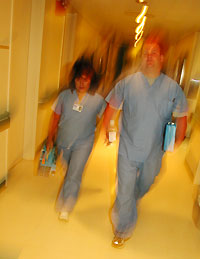|
This is an archived article.
For the latest news, go to the
Advance Homepage
For more archives, go to the Advance Archive/Search Page. | ||
|
John Dempsey Hospital Restructures Nursing Financial difficulties four years ago forced the Health Center to take a top-to-bottom look at all its operations with an eye to economizing and streamlining. High on the review list was the nursing staff, which represents a major portion of the Health Center's personnel costs.
The review has resulted in a complete restructuring of the nursing staff, aimed at providing more consistent patient care and cutting down on the use of expensive agency staff. "For years, the nursing department prided itself on the fact that our patient care staff was all registered nurses (RNs)," says Jeanne Lattanzio, director of nursing and chief of operations for John Dempsey Hospital. "But as the hospital grew, that model became too inefficient and too expensive. Through the redesign, we wanted to increase the number of nurses at the bedside and we wanted to protect them from activities that took them away from the patients." To make that happen, the administration took two big steps. First, it expanded its nursing staff by retraining licensed practical nurses (LPNs) to perform patient care duties previously performed only by registered nurses. Secondly, it expanded the transportation office by hiring seven new aides and reorganizing the way they do business. "For years, we had licensed practical nurses working as medication nurses but not providing direct patient care," says Donna Pryor, a nurse manager. "By retraining them, we increased the number of nurses at the bedside." The retraining - nine full days of classes followed by a month-long preceptorship - included instruction in taking vital signs, starting IVs, and using equipment like tubes and drains. "Now as staff nurses," says Pryor, "they are handling all aspects of care for the patients in their charge, including medications. It's really better overall care and much more efficient." Expanding and reorganizing the transportation office was the second major piece of the restructuring. "Because of the nursing shortage and the need to cover staff vacancies and vacations, our nurses were doing about 45 to 50 percent of all the transporting duties," says Lattanzio, "and we were spending more than a million dollars a year on agency nurses to fill in gaps in coverage." The administration hired seven new aides for transportation and moved their office from the sub-basement to a more central location on the third floor of the hospital. In addition, one of the aides was given the job of dispatcher or lead transportation aide to assign and prioritize tasks. "All the aides now have radios so the dispatcher can contact them directly and they can talk to each other," says Shelley Dietz, nurse manager for staffing/payroll, float pool, and transportati on services. "We have our response time down to five minutes, and nurses know they can count on the aides to do tasks that used to take them away from their patients." Kathleen Coyne, nurse manager of the Intensive Care Unit and respiratory/pulmonary services, says that now, "the dispatcher sees the big picture. She knows where all the aides are and assigns tasks according to established priorities. It really streamlines the process for the aides and for the nurses." The restructuring process was overseen by a committee, with subcommittees involving the people who would be affected by the change looking at each piece of the restructuring. Meetings were also held with union leaders, and union members served on the subcommittees. Lattanzio says the restructuring has been a success: "I really believe we are providing better, more consistent care to our patients." |

